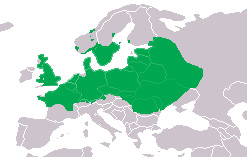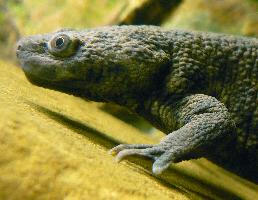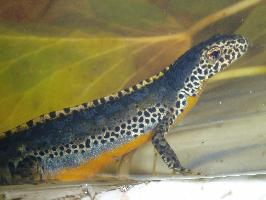
Súlyok és méretek
| Hossz | 15-tól 18-ig cm |
|---|
Állatleírás
The Northern crested newt, scientifically known as Triturus cristatus, is a captivating amphibian that belongs to the family Salamandridae. This species is distinguished by its remarkable physical appearance and fascinating lifecycle, which have made it a subject of interest among naturalists and conservationists alike.Adult Northern crested newts can reach lengths of up to 16 centimeters, making them one of the largest newt species in their geographic range. They exhibit sexual dimorphism, meaning males and females can be distinguished by their physical characteristics, especially during the breeding season. Males are particularly striking, with a pronounced, jagged crest that runs along their back and tail, which they flaunt during courtship displays. This crest, combined with their dark, warty skin, sprinkled with lighter spots, gives them an almost prehistoric appearance. Females, while lacking the dramatic crest, have a smoother skin texture and a more streamlined silhouette, with a yellowish belly that is speckled with dark spots.
The habitat of the Northern crested newt spans across much of Europe, from France and the UK in the west, stretching eastwards to Russia, and reaching parts of Scandinavia in the north. They favor a temperate climate and are primarily found in deciduous forests, meadows, and marshlands, showing a particular preference for ponds and slow-moving streams for breeding.
The lifecycle of Triturus cristatus is intriguing, as it encompasses both aquatic and terrestrial phases. They breed in water, where an elaborate courtship dance ensues, involving the male displaying his crest and performing a series of movements to attract a mate. Females lay their eggs individually on aquatic plants, wrapping each egg carefully in leaves for protection. Once hatched, the larvae are fully aquatic and undergo a metamorphosis, developing lungs to replace their gills before they can venture onto land.
Despite their adaptability, Northern crested newts face threats from habitat loss, pollution, and disease. Urbanization and intensive agriculture have led to a decline in suitable breeding sites, while pollutants and invasive species pose significant risks to their populations. As a result, Triturus cristatus is protected under various conservation statutes across its range, including the European Union's Habitats Directive, which mandates member states to take special measures to protect the species and its habitats.
In conclusion, the Northern crested newt is a fascinating and complex creature, embodying the intricate balance of ecosystems they inhabit. Their unique characteristics and lifecycle highlight the importance of amphibian conservation efforts, not only for the species itself but also for the broader ecological communities to which they belong.
Előfordulási térkép

Hasonló állatok
Új állatfotók
Top 10 állat
- Dolphin gull (Leucophaeus scoresbii)
- Japanese macaque (Macaca fuscata)
- Stone loach (Barbatula barbatula)
- Russian tortoise (Testudo horsfieldii)
- Galápagos tortoise (Geochelone nigra complex)
- Greek tortoise (Testudo graeca)
- Diana monkey (Cercopithecus diana)
- Common flying dragon (Draco volans)
- Moustached guenon (Cercopithecus cephus)
- Galápagos penguin (Spheniscus mendiculus)


